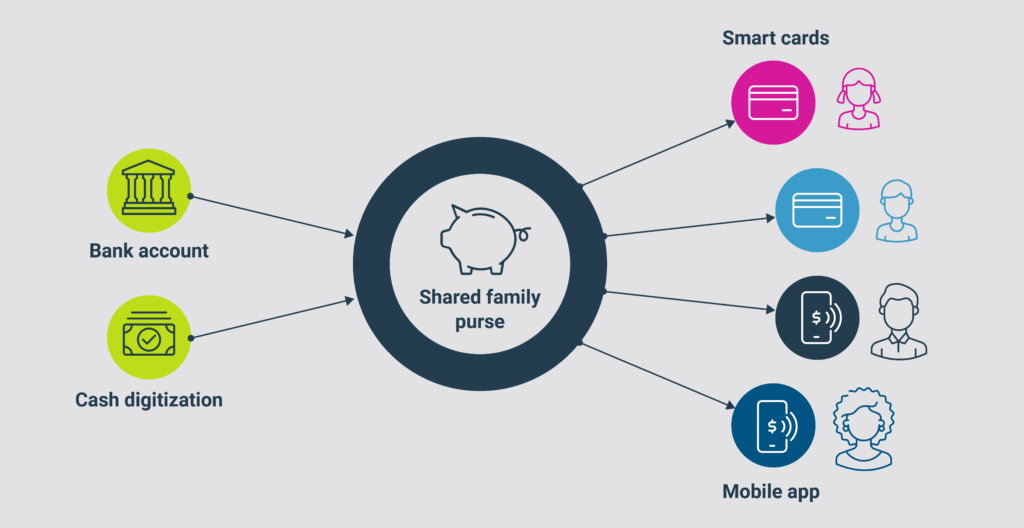Family friendly features are a must-have in transit grant applications under the current administration. This doesn’t mean your agency has to change which fare collection solutions it proposes to win grants – it’s what features you choose to highlight and how you frame their benefits that make the difference.
Fortunately, Genfare’s fare collection solutions are already family friendly. With account-based ticketing, it’s easy for families to share a purse and for a parent or other member of the family to manage and fund fares for everyone. This works for families of all sizes, and can include anyone the account holder chooses, such as grandparents, children, spouses, and other members of the household.
 “It’s great because you don’t have to worry about setting up and maintaining separate accounts for each member of the family,” says Genfare program manager Kiran Chaudhari. “You can fund and track the spending and usage by everyone in the family from a single credential.”
“It’s great because you don’t have to worry about setting up and maintaining separate accounts for each member of the family,” says Genfare program manager Kiran Chaudhari. “You can fund and track the spending and usage by everyone in the family from a single credential.”
Family-friendly fare collection isn’t just for grant applications – explaining how to use it and the promoting the benefits to families can help build your agency’s image as community-focused.
Kiran explains how it works:
Dedicated fare media
The family purse works no matter which account-based dedicated fare media the family uses. “It’s no different from a family’s shared checking account,” says Kiran. “Even if it’s a single account, there can be multiple debit cards or checkbooks for family members to access the money through.”
Mobile Link
With Mobile Link, a single bank account can be linked to everyone in the family’s phone or tablet with a family purse. This allows everyone in the family to draw from the family purse from their own device. The Fast Fare farebox is equipped with a bar code reader to validate mobile app tickets.
e-Fare
The e-Fare platform allows the account holder to view the account, add to the account, or access customer service, from any web-enabled device. It works with Mobile Link and smart cards. While many of the features are also available on Mobile Link, it may be more convenient for the accountholder to view them on the larger screen of a tablet or computer.
Smart cards
If an agency has account-based smart cards, family purses can be enabled. Each person in the family will have their own card, funded from the same account. Just like single-family accounts, the main account holder can choose auto-replenishment at the thresholds they prefer or can allow manual topping up only.
LUCCs
For agencies with limited use fare media, they can sell packs of LUCCs designed for family use – for instance a 10-pack of single-ride tickets and a 5-pack of weekly unlimited passes can be among the offerings. Families can then purchase those packs and distribute them to family members. While not truly account-based, LUCCs do have some account-like features. If the family registers the LUCCs, they will be able to freeze lost or stolen cards and replace them.
Mixed media
A family can share a purse even if some members of the family use one fare media, such as Mobile Link, and others use a different one, such as a smart card. Or, any one person could have both a smart card and Mobile Link connected to the same account. Funds will be drawn from the same account and tracking and replacement will be available.

Open Payment
With open payment, the account isn’t with the transit agency – it’s with the riders’ banking institution. That said, a shared purse works similarly to account-based dedicated fare media. All riders in the family can be funded by the same debit card, credit card, or mobile wallet.
If the family has just one copy of the card or mobile wallet, the person holding the card or smartphone can present the payment as many times as there are people riding on the trip. No family account needs to be pre-arranged. The rider simply tells the driver how many full-fare and reduced-fare rides they are paying for, then taps the card once for each rider they are traveling with.
Alternately, if some members of the family have their own card on the account or the card is entered into other family members’ mobile wallet, the rider can tap for themselves and the fare will be debited from the shared account.
Features for families
The same features available on single-rider account-based fare media also work for families using shared purses. “In some cases, these features can be even more valuable for family use,” says Kiran.
Reduced fares
If some members of the family may rider for a reduced fare, the rider can alert the driver and, if necessary, present valid proof they are eligible for a student, senior, veteran, or other reduced fare. The driver can then indicate reduced fare status on the operator control unit (OCU) so the appropriate amount is debited. At some transit agencies, dedicated reduced fare media is distributed to approved riders, so the rider does not have to alert the driver.
Tracking
The account holder can view all the information the transit agency makes available to riders. This goes beyond simply how much money has moved in and out of the account to include ridership data such as when each member of the family boarded transit, where, and on what line.
Auto-reload
For pre-funded fare media such as smart cards or Mobile Link, auto-replenishment is an option. The main account holder can choose auto-replenishment thresholds and amounts to be added with each reload. For example, the purse could automatically receive $50 from the account holder’s checking account every time the balance goes below $10 – it’s up to the account holder. The account holder also has the option to allow manual reloads only.
Period passes
Period passes can also be purchased, manually or automatically, from a shared family purse. For example, if one parent and one student take the bus daily, and one parent and the other children only take the bus occasionally, the account can be set up to purchase one full-fare monthly pass, one student fare monthly pass, and also be available to fund individual rides for the other parent and children.
Lost or stolen cards
If a family member loses their card or mobile phone, their card can be turned off and reissued without affecting the rest of the family, as long as it was reported missing before an unauthorized rider used the funds. If it’s reported after the funds were stolen, the account will enter the transit agency or bank’s recovery process.
Cash digitization
Just like a single-person rider account, a shared purse can be topped up with cash at any ticket vending machine, point of sale terminal, or InComm location. Any member of the family can add funds, and the amount will be available to everyone on the account. These methods are not just for cash — family members can also add funds at a TVM or APOS/RPOS using a bank card. They just need to present their smart card or Mobile Link to direct the funds to the family account.
Fare capping
Fare capping also works with shared family purses across fare media, including open payment. The caps are specific to each individual even though the account has a shared purse. For example, if the full-fare monthly cap is $100 and the student reduced fare monthly cap is $50, and one parent and one student meets their cap, they would no longer be charged for rides. If the other parent has not met their cap, they would continue to pay for rides from the shared family purse.
Security
There are safeguards put into place to ensure that family accounts are secure for both the riders and the transit agency. For example, if fare capping is being used, the system knows which riders are using the account, so, for example, if there are 30 rides costing $2 each taken by 4 family members, the system will know not to put a $60 monthly pass fare capping threshold into place because no one member of the family has met that threshold.